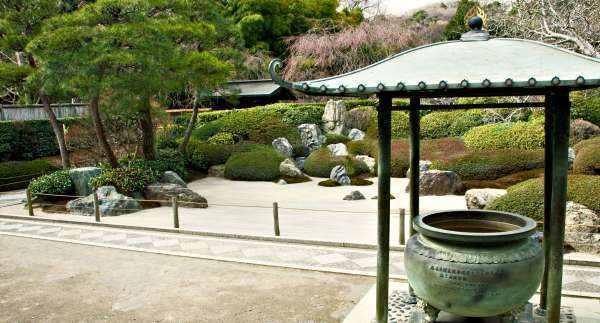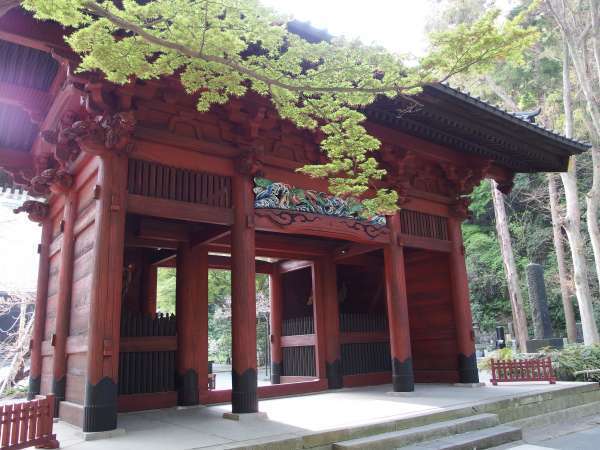Kamakura is a place well known for its thousands of Buddhist temples. We have chosen five that stand out, not only for their historical significance, but for their large array of trees, flowers, and beautiful gardens:
Hasedera Temple

(image by upload.wikimedia.org)
If you set aside time to visit Kamakura during your trip to Japan, Hasedera Temple is one of the spots that must be visited during your time in Kamakura city. The wooden carving of the Kannon Bosatsu in the main hall, also known as the Buddhist Goddess of Mercy, towers at a colossal height of 9.8 meters and is the largest of its kind domestically. The eleven-faced wooden seated statue of the Kannon Bosatsu has been designated as an important cultural property in Japan. In addition to the significant cultural properties present at the temple, there is also a gazebo from where you can catch stunning views of the city and ocean of Kamakura city. Moreover, the beautiful garden with its flowers blooming all year long makes the temple a paradise. In particular, the blooms of the hydrangeas and iris flowers are considerably exquisite.
After you take the time to explore Hasedera Temple and its surroundings, you could perhaps take on the challenge of participating in the copying of sutras (shakyo) and tracing of Buddhist images (shabutsu). This activity is an everyday occurrence at the temple. The former activity refers to the copying by hand the sutras of the Buddha and similarly, the latter refers to the drawing of images of the Buddha. As you will only need to trace the rough copy of the scripture or drawing with a writing brush, there is no need to worry if you cannot write Japanese to participate in this activity. Historically, the transfer of sutras and images was practiced to reach enlightenment but in recent years and in the modern context, these two practices have risen in popularity for its relaxing effects. After finishing the copying of the sutras and images, you have the option to give your finished work as an offering to the temple.
Admission: Adult: ¥ 300 / Child: ¥ 100
- Guidebook from Planetyze about Hasedera Temple
- Reviews from TripAdvisor about Hasedera Temple
- Tours of Hasedera Temple
Ankokuron-ji Temple

(image by upload.wikimedia.org)
Ankokuron-ji is highly popular for beautiful flowers all year round even in Kamakura. Many people visit for the peach, weeping cherry blossoms and hydrangea in early spring and for the changing colors in fall. From early June, the hydrangeas in full bloom are planted all over the temple grounds, and the path to the temple from the Sanmon gate, the area in front of the main hall and even at the Nanmenkutsu cave at the rear of the temple are surrounded by colorful hydrangeas.
The unusual Myohozakura mountain cherry trees that have been designated as a Natural Monument have an age of 760 years. Even during the peak season, there are relatively few visitors so it is popular as a little-known spot. Early to mid-April is the best time to come. If you walk up the stone steps beside the Gohokutsu cave, you will reach Fujimidai, a sightseeing point where you can view the city of Kamakura, the seaside and even Mt. Fuji. Nichiren apparently read Buddhist scriptures from this point while facing Mt. Fuji. Ahead of Fujimidai, there is a mountain road among the thick forest. It’s said that whenever he felt besieged in his thatched hut, he would escape along that road and head into the back mountains.
Admission: ¥ 100
- Guidebook from Planetyze about Ankokuron-ji Temple
- Reviews from TripAdvisor about Ankokuron-ji Temple
- Tours of Ankokuron-ji Temple
Jochi-ji Temple
 (image by upload.wikimedia.org)
(image by upload.wikimedia.org)
The temple was built to pray for the repose of the soul of the son of the 5th shogun during the Kamakura Era. At the arched bridge in front of the main gate, there is a well called the Kanro-no-I (Well of Sweet Dew). It is one of the Ten Wells of Kamakura whose water is reportedly as sweet as honey, thereby giving it the name, but currently it cannot be drunk. Going past the main gate, you can see the Shoromon gate. Designed in the Chinese style, it is an unusual gate that has a bell hanging on the 2nd level. Then, going beyond the Shoromon, you will see the Dongeden Buddhist temple to your right. Three wooden statues of Buddha representing the past, present and future are designated as the prefecture’s Important Cultural Properties. In the back, there is a shoin drawing room (interior is not open to the public). The straw-thatched roof is of simple design and can be enjoyed alongside the flowers of the season. Going around the shoin, the road branches off. There is a sign stating “The God of Happiness is waiting for you in the cave” and a small entrance in which once you enter, you will see a stone statue of one of the Seven Lucky Gods, Hotei-son, among the yagura tombs. It is said that rubbing his belly will bring happiness. Just 5 minutes’ walk from Kita-Kamakura Station, the temple is also the starting point for The Pilgrimage for the Seven Lucky Gods in Kamakura and Enoshima.
Jochi-ji Temple is a temple of flowers. Various flowers of many types bloom all year round. Even among these varieties, leisurely viewing the hydrangeas of Kamakura is comparatively more popular than the adjacent temple. The 120-year-old Tahitigan cherry tree has been selected as one of The Top 100 Famous Trees of Kanagawa. Beautiful yellow flowers of Japanese allspice bloom even in the winter. Even aside from the flowers, you can also see valuable examples of flora such as the Kamakura City Natural Monument of Chinese juniper and an umbrella pine that boasts a size that is tops in Kamakura.
Admission: Adult: ¥ 200 / Child: ¥ 100
- Guidebook from Planetyze about Jochi-ji Temple
- Reviews from TripAdvisor about Jochi-ji Temple
- Tours of Jochi-ji Temple
Meigetsu-in Temple

(image by upload.wikimedia.org)
The hydrangea of Meigetsu-in are basically restricted to the ancient Japanese variety known as hime ajisai (princess hydrangea), and their blue blossoms at the beginning of June give a refined and mysterious atmosphere to the path from the main gate to the Chuumon gate. The initially light blue blossoms change into a deeper blue as the flowers enlarge. This beautiful appearance is called Meigetsu-in Blue and is greatly admired. The time that the hydrangea start blooming in conjunction with the blossoming of the irises in the rear garden behind the main hall which is only open to the public at that time is not to be missed.
The main hall has 2 gardens with a dry landscape garden in front and a rear garden. The dry landscape garden, unusual in Kamakura, is rich in seasonal colors which include cherry blossoms and azalea. The rear garden is only open in June for the irises and from late November to early December for the autumn leaves. There is a round window in the back of one room, the Satori-no-Mado, that has become synonymous with Meigetsu-in, and symbolically expresses truth and understanding through the circular shape of the cosmos. The normally inaccessible rear garden can only be seen from here. Kamakura’s largest yagura tomb is located in Meigetsu-in. With an entry width of 7m, a length of 6m and a height of 3m, it is the final resting place of Shigefusa Uesugi, the man who built Meigetsu-in, and on the wall face is carved the Buddha and the 16 Arhats (Buddhist saints). The Tsurube-no-I (Tsurube Well) is one of the Ten Wells of Kamakura (ten wells which have water of especially high quality) and its interior resembles the bulge of a water jar. It is a precious well that is being used even now.
Admission: ¥ 300
- Guidebook from Planetyze about Meigetsu-in Temple
- Reviews from TripAdvisor about Meigetsu-in Temple
- Tours of Meigetsu-in Temple
Myohon-ji Temple
 (image by flickr.com)
(image by flickr.com)
Myohon-ji Temple is one of the oldest Nichiren temples of Japan, alongside Kuon-ji and Ikegami Honmon-ji. Walking along the cedar-lined temple path from the gravitas-laden main gate, you will encounter Niten-mon Gate. Jikokuten and Tamonten, two of the Four Heavenly Kings of Buddhism, are enshrined within. If you clap your hands in front of the dragon carving above at the front of the gate, there is a legend that you can hear the cry of the dragon. In back of Niten-mon, there is a plant known as the Chinese trumpet vine, and in the summer, it has splendid orange blossoms. Beyond the gate stands Soshi-do, the largest wooden structure in Kamakura.
Constructed in the Edo Era, a statue of Nichiren is enshrined there. Within the temple grounds, the Hall crabapple is one of the three main types of crabapple in Kamakura, and its pale pink flowers signify the beginnings of spring. The peak time to see the Hall crabapple is also the best time to see the weeping cherry trees in front of the main hall. The gingko trees have been designated as Natural Monuments by the city of Kamakura. During autumn, there are brilliant colors from the trees such as the maple. But the secret to the temple’s popularity is its silence. The site facing Mt. Gion has an atmosphere deep in mountains. The long temple path surrounded by mountains has an increasing stillness as you walk along it. A 10-minute walk from the station, time passes quietly such that it is hard to believe that a tragedy had taken place there.
Admission: Free
- Guidebook from Planetyze about Myohon-ji Temple
- Reviews from TripAdvisor about Myohon-ji Temple
- Tours of Myohon-ji Temple